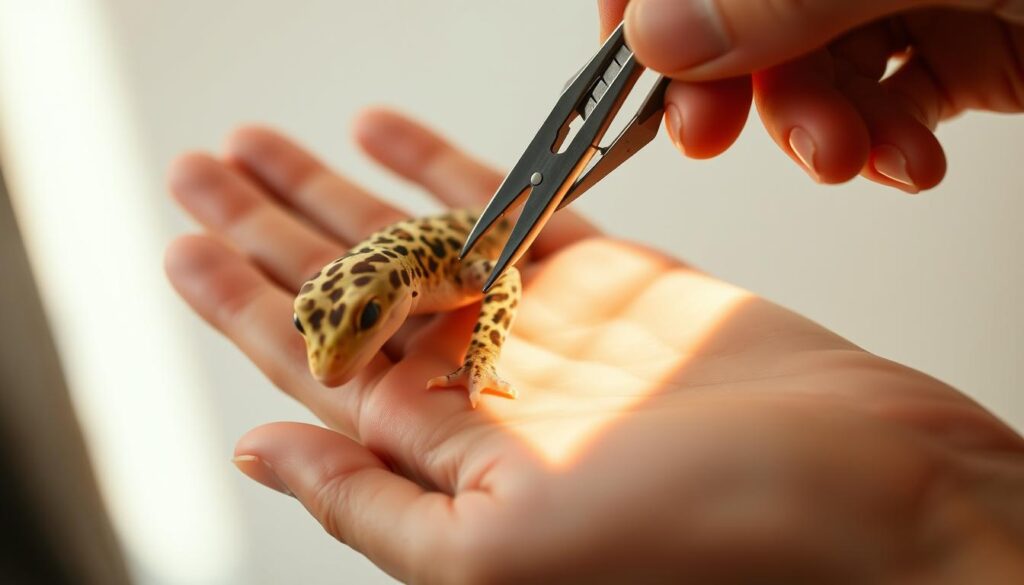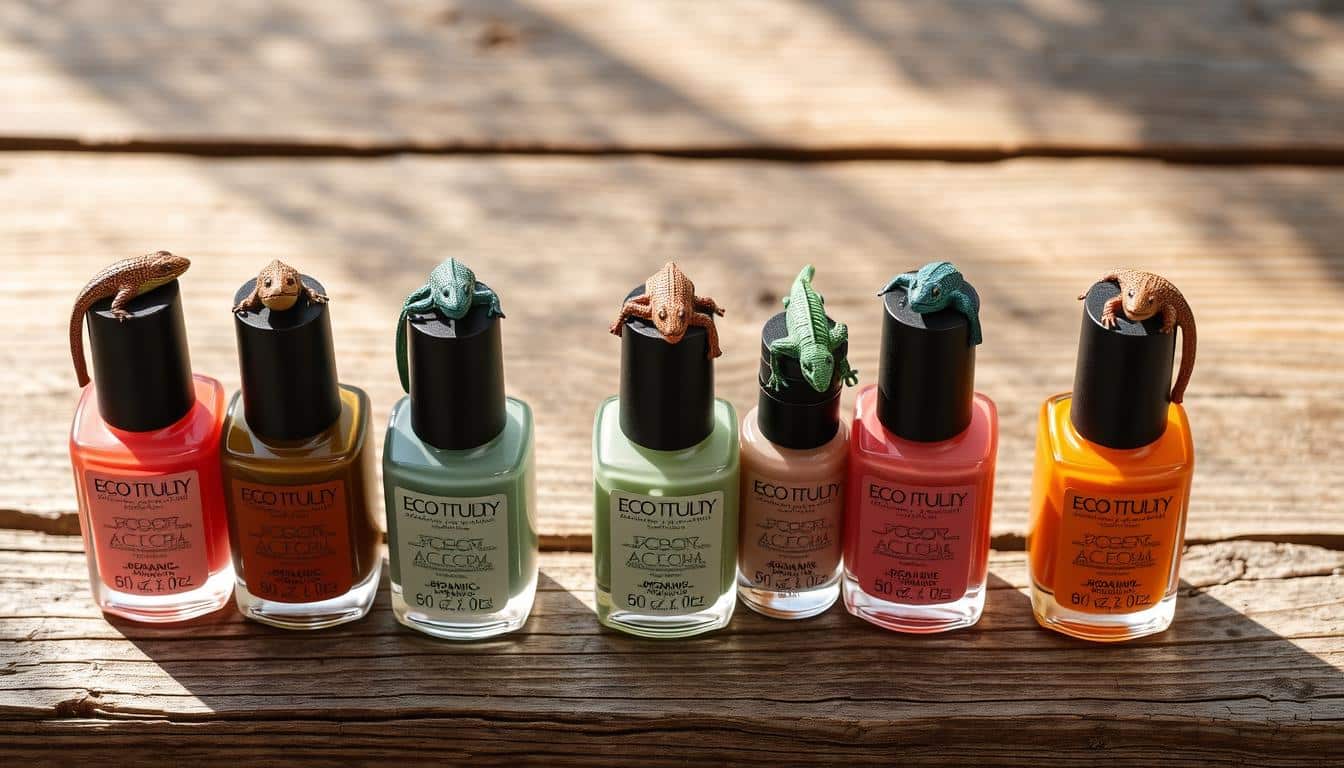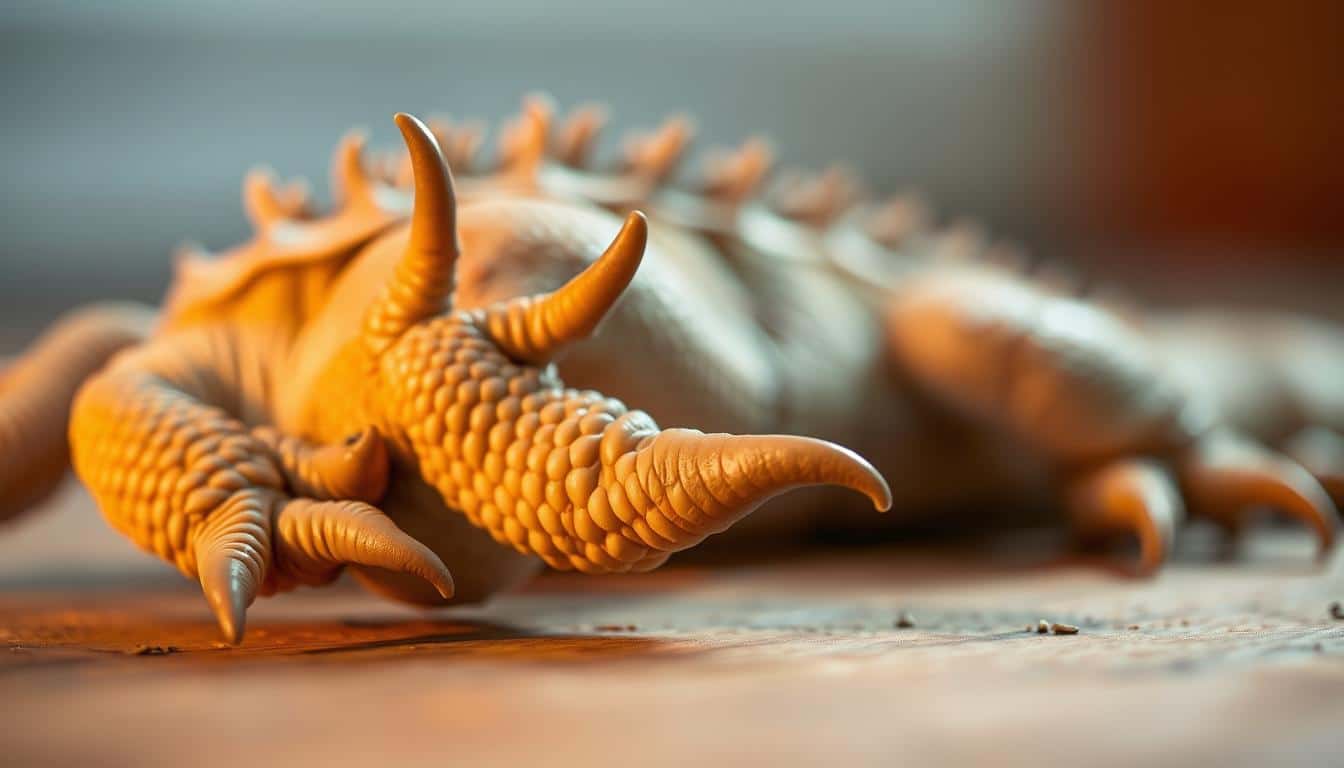Anúncios
When caring for leopard geckos, some pet owners forget about items like nail polish. This product can be harmful, especially to their breathing. The chemicals in nail polish can harm these reptiles. Knowing the dangers helps keep your gecko happy and healthy.
Understanding Leopard Gecko Health
Leopard geckos are loved as pets for their small size and calm nature. Taking good care of them is key to their health and long life. They need the right food, plenty of water, and a comfy home to live well.
It’s important to keep an eye on their health. Taking them to the vet regularly helps spot any health issues early. If we care for them right, leopard geckos can live 10 to 20 years. They need the right light and a warm place to stay healthy. Without this care, they might get sick.
The Importance of Proper Enclosure Setup
A well-structured enclosure is key for a leopard gecko’s health and happiness. The best space for an adult is a 40-gallon breeder tank, measuring 36″ x 18″ x 16″. This gives them room to burrow and control their body temperature.
Having areas of different temperatures is crucial. Geckos need these to stay healthy. Their home should also have hides, giving them a sense of safety and comfort.
Making their home similar to their natural habitat reduces stress. Providing the right size and setup lets your gecko live its best life.
Can Your Nail Polish Give Your Leopard Gecko Respiratory Issues?
Nail polish might not be safe for your leopard gecko. It contains hazardous substances called volatile organic compounds (VOCs). These can pollute the air your pet breathes. Since leopard geckos are especially vulnerable to these compounds, owners should be cautious when using nail polish around them.
Potential Dangers of Common Household Products
Many everyday items, like nail polish, harm indoor air quality. Harmful chemicals from nail polish, cleaners, and air fresheners fill the air. For leopard geckos, this exposure means a higher chance of respiratory problems.
- Nail polish and its chemical components
- Cleansing agents that release harmful fumes
- Air fresheners that mask odors with toxic substances
Geckos exposed to these toxins are more likely to have breathing issues. Paying attention to these risks is important for their health.
Signs of Respiratory Issues in Leopard Geckos
Knowing the signs of respiratory problems is key. Look out for:
- Wheezing sounds during breathing
- Labored or difficulty breathing
- Lethargy and lack of activity
- Any unusual discharge from the eyes or nose
Spotting these early helps keep your pet healthy. If you see these symptoms, get help from a vet right away.
Nail Polish Components and Their Risks
Nail polish contains chemicals that can be harmful. This is true for humans and leopard geckos alike. If you own a pet, it’s important to know these harmful ingredients. This knowledge helps keep your reptilian friend safe.
Common Chemicals in Nail Products
Many nail products have chemicals like:
- Toluene: This solvent can cause breathing problems.
- Formaldehyde: Being a preservative, it’s bad for the immune system when exposed.
- Dibutyl Phthalate (DBP): This plasticizer is linked to developmental issues in animals.
How These Chemicals Affect Leopard Geckos
These chemicals can really affect leopard geckos’ health. Here are some effects:
- They can weaken the immune system, making geckos more sick.
- They might cause breathing troubles.
- They can lead to long-term health problems, like not growing properly or not living as long.
Keeping pet areas free from nail polish chemicals is key. This protects the health of leopard geckos.
Environmental Factors Influencing Leopard Gecko Health
Leopard geckos do best in places like their natural homes. They need the right temperature, humidity, and air quality to stay healthy. By managing these factors, you can make a good home for them.
Temperature and Humidity Requirements
They need a temperature between 70°F and 95°F. This helps them control their body temperature. The humidity should be 30% to 40%, similar to the dry areas they come from. These conditions help them digest food and avoid stress.
Impact of Air Quality on Leopard Geckos
The air quality around them is very important. Things like dust, household chemicals, and not enough fresh air can harm them. Bad air can cause breathing problems. So, cleaning their home often and possibly using air filters is crucial for their health.
Suggestions for Safe Nail Care Around Leopard Geckos
Keeping your nails nice without harming your leopard gecko is key. Use nail care items that are safe and free from bad chemicals. Here are some tips:
- Choose water-based nail polishes to cut down on harmful fumes and safer components.
- Steer clear of products with harsh chemicals which can harm your gecko’s surroundings.
- Do your nail grooming in another room, away from your leopard gecko, to keep it safe from fumes.
- Opt for non-toxic alternatives that are good for you and your gecko.
By following these steps, you make a safe space for your gecko while keeping up with your grooming.

Preventative Measures for Ensuring Gecko Safety
Taking steps ahead of time helps keep your leopard gecko healthy. By adding preventative care, they stay safe from dangers. This makes sure they live well and free from harm.
Alternative Products for Nail Care
It’s important to look at nail care items that are safe. Choose products without harmful chemicals for better air. Also, pick nail polish removers without acetone. They’re less harsh indoors. These choices help keep your gecko healthy without changing how you take care of your nails.
Creating a Safe Environment for Your Gecko
To make a safe home for your gecko, you need to do a few things. Make sure their space is well-ventilated to avoid bad chemicals. Don’t use strong cleaners nearby to protect their breathing.
Using air purifiers makes the air cleaner for them. Keeping the right humidity and cleaning small messes stops germs. This helps your gecko stay in a healthy place.
Best Practices for Leopard Gecko Ownership
Owning a leopard gecko means taking care of them properly. It’s about making sure they are happy and healthy. Regular health checks and the right living conditions are key. These steps help ensure your gecko thrives.
Regular Health Monitoring Techniques
It’s important to check on your gecko often. Watch how they eat, act each day, and look. Notice any odd behaviors or signs they might not be well. Regular vet visits are also crucial for their wellbeing.
Maintaining Optimal Living Conditions
Creating the perfect home for your gecko is essential. Check their living space often to meet their needs. Important steps include:
- Checking temperature and humidity levels frequently.
- Providing fresh food and clean water at all times.
- Ensuring a sanitary environment to minimize health risks.
Conclusion
Knowing the risks household products pose, especially nail polish, is key for keeping leopard geckos healthy. These captivating reptiles are sensitive to their surroundings. Harmful substances in nail products can cause breathing problems and other health issues. By understanding the dangers in your beauty routine, you can make your home safer for your pet and yourself.
Ensuring pet safety is a must for every pet owner. Safe nail care practices and choosing alternative products can lower the dangers of nail polish. Also, watching your leopard gecko’s behavior and health helps keep them safe.
Taking active steps and being informed about your pet’s surroundings are crucial for a healthy home for your leopard gecko. By putting their needs first and avoiding dangerous materials, you can have a rewarding relationship with these amazing reptiles for many years.



